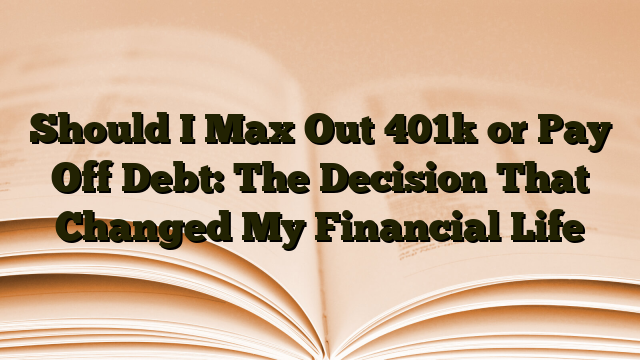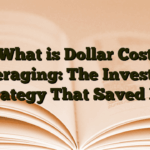Should I Max Out 401k or Pay Off Debt: The Decision That Changed My Financial Life
I sat at my kitchen table with two spreadsheets open, feeling paralyzed. On one side, my 401k dashboard showed a measly $12,000. On the other, credit card statements totaling $18,000 at 22% interest. I was 28 years old, finally making decent money, and I had no idea which problem to attack first.
My dad kept telling me to max out the 401k. My friend Sarah swore I should demolish the debt first. Even the financial advice online contradicted itself. One article said compound interest is king, another said debt is the enemy.
Here’s what I learned after wrestling with this decision, making some expensive mistakes, and finally finding a strategy that actually works.
Why This Question Keeps You Up at Night
The “should I max out 401k or pay off debt” dilemma feels impossible because both choices seem urgent. Miss out on decades of compound growth, or stay buried under high-interest debt? It’s like asking whether you’d rather breathe or eat.
But here’s the thing nobody tells you: this isn’t actually an either-or decision for most people. The real question is about sequencing and percentages, not all-or-nothing choices.
Recent research shows that debt creates real psychological burden. People carrying high debt loads experience measurable anxiety and impaired decision-making, which creates a vicious cycle. You can’t think clearly about your financial future when you’re drowning in the present.
At the same time, every year you delay retirement savings costs you real money. A 25-year-old who invests $5,000 once and never touches it will have more at retirement than someone who starts at 35 and contributes $5,000 annually. That’s the brutal math of compound interest.
The One Rule That Actually Matters
After talking to three financial advisors and reading everything I could find, I discovered one rule that made everything click: match the interest rates.
If your debt interest rate is higher than your expected investment return, pay off the debt first. If your expected investment return is higher than your debt interest rate, invest first.
Sounds simple, right? Here’s where it gets tricky.
The stock market has historically returned about 10% annually, but financial advisors typically use 7% for conservative planning. In 2025, the average credit card interest rate is 24%. That’s not even close. Credit card debt at 24% is financially destroying you three times faster than the market could possibly save you.
But what about a car loan at 4%? Or student loans at 5%? Now we’re in the gray zone where personal circumstances matter more than universal rules.
The Priority Sequence That Actually Works
Here’s the framework I wish someone had given me five years ago. Follow this order, no matter what anyone tells you:
Step 1: Build a starter emergency fund
Before you pay extra on anything, save $1,000 to $2,000 in cash. This prevents you from going further into debt when your car breaks down or you get hit with an unexpected medical bill. Keep this money in a high-yield savings account where it earns 4-5% while staying accessible.
Step 2: Get the full employer 401k match
This is the only true “free money” in personal finance. If your employer matches 50% of your contributions up to 6% of your salary, that’s an instant 50% return on your money. No debt interest rate comes close to beating that.
According to recent data, the average employer match in 2025 is about 4.7% of pay, with the most common structure being dollar-for-dollar on the first 3% and 50 cents on the dollar for the next 2%. That means a $60,000 salary with this match formula gets $2,400 in free money annually just for contributing $3,000.
Missing the match to pay off debt faster is like refusing a 50-100% raise. Don’t do it.
Step 3: Obliterate high-interest debt
Anything above 7-8% interest needs to die. Credit cards, payday loans, high-interest personal loans – these are financial emergencies. Every dollar you throw at this debt saves you 15-25% annually. That’s a guaranteed return that the stock market can’t match.
I had $18,000 in credit card debt at an average of 21% interest. That was costing me $3,780 per year in interest alone. Meanwhile, I was contributing an extra $200 monthly to my 401k beyond the match, feeling virtuous about “investing in my future.”
I ran the numbers one night and wanted to punch myself. That extra $200 monthly toward the credit cards would have saved me $42 in interest the first month, $40 the next month, compounding downward. Over two years, I would have saved over $4,000 in interest while also freeing up monthly cash flow.
Step 4: Complete your emergency fund
Before maximizing retirement contributions, you need 3-6 months of expenses in cash. This number depends on your job stability and personal risk tolerance. I keep six months because I’m self-employed and anxious. My friend who works for the government keeps three months and sleeps fine.
The emergency fund debate comes down to this: would you rather miss some investment gains, or risk going into debt again when life happens? I chose security after learning this lesson the expensive way.
Step 5: Increase retirement contributions
Once high-interest debt is gone and your emergency fund is solid, now you can start ramping up 401k contributions. Aim for 15-20% of your gross income including the employer match. This keeps you on track for a comfortable retirement while still having money to live today.
Step 6: Tackle low-interest debt strategically
Mortgages at 3-4%, student loans at 5%, car loans under 6% – these sit in the “maybe pay extra, maybe invest instead” zone. The math says invest if you can beat the rate, but the psychology says debt freedom has value beyond spreadsheets.
I currently have a car loan at 3.9%. Mathematically, I should invest the extra money instead. Psychologically, I hate having the payment. I split the difference: I max my Roth IRA first, then send extra payments when I have breathing room in the budget.
The Math They Don’t Show You
Let’s put actual numbers on this to see why sequence matters so much.
Scenario A: Max 401k First, Ignore Debt
You contribute $500 monthly to your 401k beyond the match ($6,000 annually). Meanwhile, you have $15,000 in credit card debt at 22% interest, making minimum payments of $450 monthly.
After one year:
– Your 401k grows to roughly $6,420 (assuming 7% return)
– Your credit card balance drops to $12,600 (most of the payment went to interest)
– You paid $3,300 in credit card interest
– Net position: -$8,480
Scenario B: Crush Debt First, Then Invest
You contribute only enough to get the employer match, then throw the remaining $500 monthly at the credit card.
After one year:
– Your credit card balance drops to $8,400
– You paid $1,980 in interest
– You saved $1,320 in interest compared to Scenario A
– Your monthly minimum payment dropped from $450 to $252
After 18 months total, your credit card is paid off. Now you redirect that $500 monthly plus the freed-up $252 from minimum payments into your 401k – $752 monthly, or $9,024 annually. You’ll catch up to Scenario A’s retirement savings faster than you think, and you’re doing it debt-free with lower stress.
The person who pays off debt first ends up ahead both financially and psychologically within three years. The crossover point where they have more money saved happens around month 32, and after that, the gap widens in their favor forever.
When the Standard Advice Breaks Down
The “pay off debt first” advice assumes you’re rational, disciplined, and have stable income. Real life is messier.
You might prioritize 401k contributions if:
- You’re in your early 20s with decades to compound. Time is your biggest asset, and starting early can outweigh moderate debt.
- You have low-interest debt (under 5%) and strong earning potential. A software engineer with $30,000 in 4% student loans might maximize 401k contributions instead.
- Your job offers an unusually generous match (10%+ of salary). This free money might be worth carrying moderate debt to capture.
- You’re approaching retirement age. A 55-year-old needs to prioritize retirement savings more aggressively than a 25-year-old with the same debt.
You might prioritize debt payoff if:
- Debt keeps you up at night. The psychological burden has real costs – stress, health problems, relationship strain. Sometimes peace of mind beats optimal spreadsheet returns.
- You have any high-interest debt (8%+). The math is just too punishing to ignore.
- Your income is unstable. Debt payments are mandatory; retirement contributions are optional. Flexibility matters when you’re self-employed or work on commission.
- You’re drowning in minimum payments. If debt payments consume more than 30% of your take-home pay, you need to address this crisis before thinking about retirement.
The Mistakes That Will Cost You Thousands
Mistake 1: Withdrawing from your 401k to pay off debt
This seems logical until you face the consequences. You’ll pay income tax on the withdrawal plus a 10% early withdrawal penalty if you’re under 59½. That $10,000 withdrawal costs you $3,500+ immediately, plus you lose decades of compound growth on that money. Financial advisors unanimously agree this is a last resort option.
Mistake 2: Ignoring the employer match to be “debt free”
I watched my coworker do this. He refused to contribute anything to his 401k until his car loan was paid off, missing out on $4,000 annually in employer match. That’s $4,000 of free money he’ll never get back. The car loan interest rate was 5.9%, so he paid an extra $600 in interest over two years to avoid “splitting focus.” He lost $7,400 ($8,000 in match minus $600 saved) to feel psychologically pure. Brutal.
Mistake 3: Trying to do both halfheartedly
This was my mistake. I paid a little extra on debt while contributing a little extra to my 401k, making minimal progress on either front. I spent three years in limbo when I should have spent 14 months intensely crushing debt, then redirected that intensity to retirement. The middle path feels safe but often takes twice as long.
Mistake 4: Forgetting about tax advantages
401k contributions reduce your taxable income. If you’re in the 22% tax bracket, every $1,000 you contribute saves you $220 in taxes. Meanwhile, you’re paying credit card interest with after-tax dollars. The real cost of your credit card debt is higher than the stated rate when you account for this dynamic.
Your Personal Action Plan
Stop reading generic advice and look at your actual numbers. Grab a calculator and answer these questions:
- What’s your employer 401k match percentage and structure? Calculate the dollar amount you’d miss by not contributing.
- List every debt with its balance, interest rate, and minimum payment. Sort by interest rate from highest to lowest.
- How many months of expenses do you have in emergency savings right now? Be honest.
- What’s your effective tax bracket? This affects the real cost of debt and the real benefit of 401k contributions.
- How stable is your income? Variable income changes the risk calculation.
Now run the numbers for three scenarios:
- Match only + aggressive debt payoff
- Balanced approach with modest debt payments and 401k contributions
- Max 401k while making minimum debt payments
Project out 3 years and 5 years. Include the interest you’ll pay, the growth you’ll gain, and most importantly, when you’d be debt-free in each scenario. The answer becomes obvious once you see the actual numbers instead of wrestling with abstract principles.
What I Would Tell My 28-Year-Old Self
If I could go back to that kitchen table with my spreadsheets, here’s what I’d say:
Stop overthinking this. Contribute exactly enough to get the full employer match – not a dollar more. Take every extra dollar beyond that and destroy the credit card debt like your financial future depends on it, because it does. That 22% interest is a financial emergency, not a lifestyle choice to manage.
In 14 months when the cards are paid off, you’ll have freed up $400 monthly in minimum payments. Add that to the $500 you were throwing at debt. Now you’re contributing $900 monthly to your 401k on top of the employer match. You’ll be maxing it out within two years of becoming debt-free.
The fastest path from broke to wealthy isn’t the balanced path. It’s the intense, focused path that tackles one dragon at a time.
Use dollar cost averaging once you start ramping up contributions. You’ll invest consistently regardless of market conditions, removing the temptation to time the market or pause contributions when things feel uncertain.
The Next Steps After You’ve Decided
Once you’ve crushed high-interest debt and you’re contributing steadily to your 401k, start thinking about tax diversification. Your 401k is tax-deferred, meaning you’ll pay taxes on withdrawals in retirement. Consider adding a Roth IRA to your strategy for tax-free growth and withdrawals.
The annual contribution limit for IRAs is $7,000 in 2025 ($8,000 if you’re 50+). Many people fund a Roth IRA after maxing their 401k match but before maxing the 401k contribution limit of $23,000. This gives you flexibility in retirement to manage your tax situation.
But don’t get ahead of yourself. If you’re still carrying high-interest debt or your emergency fund isn’t complete, those goals come first. Financial foundation before financial optimization.
The Question Nobody Asks But Should
Here’s what I wish more people would consider: what’s the opportunity cost of your stress?
I spent two years carrying moderate debt while “optimizing” my retirement contributions. The debt wasn’t destroying me financially – it was 6.5% interest on a consolidated loan. But I thought about it constantly. Every purchase felt guilty. I checked my account balances obsessively. I avoided looking at my overall financial picture because it felt overwhelming.
When I finally committed to paying it off, even though it wasn’t the mathematically optimal choice, something shifted. I stopped feeling broke despite having more money in the bank. I made better decisions about everything from career moves to daily spending. The mental energy I got back was worth more than the 0.5-1% suboptimal return I might have missed.
Your financial plan needs to fit your psychology, not just your spreadsheet. If debt stress is costing you sleep, health, or opportunities, factor that into your decision. Sometimes the best financial choice is the one you’ll actually stick with.
Making the Decision and Moving Forward
The “should I max out 401k or pay off debt” question doesn’t have a universal answer because your situation isn’t universal. But it does have a framework that works for most people:
- Start with emergency savings ($1,000-$2,000 minimum)
- Always get the full employer 401k match
- Aggressively pay off debt above 7-8% interest
- Build emergency fund to 3-6 months of expenses
- Increase retirement contributions to 15-20% of income
- Handle low-interest debt based on personal preference and risk tolerance
This sequence maximizes both your financial outcome and your psychological well-being. You’re not leaving free money on the table, you’re not paying extortionate interest rates, and you’re building toward long-term wealth with a solid foundation.
The mistake is overthinking this for months while doing neither effectively. Pick your priority based on this framework, commit to it for 12-18 months, then reassess. Focused intensity beats balanced mediocrity every single time.
Your future self – the one who’s either debt-free with a growing 401k, or still carrying both debt and regret – is depending on the decision you make today. Make it based on math, not emotion. Then execute it with emotion, not hesitation.






